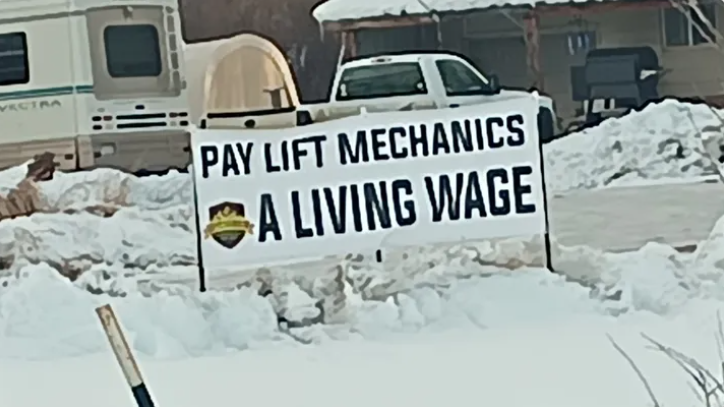
GoFundMe

Audio By Carbonatix
Lift maintenance workers at the Crested Butte Mountain Resort are bargaining on a union contract with Vail Resorts ownership, but a work stoppage is on the table.
Although recent weeks have been more positive, contract negotiations have lasted over a year, according to union president Thomas Pearman, so workers voted on January 22 to authorize a strike. Pearman, a lift mechanic at Crested Butte, says workers hope to avoid a strike but are prepared for it after seeing little progress on their contract.
If the workers strike, they would be the second group at a Vail Resorts property to do so this ski season after Park City Professional Ski Patrol Association workers in Utah, who held out from December 27 to January 8 before reaching an agreement with Vail Resorts.
“With both the ski patrol strike at Park City and our potential strike here, these are both positions that people return to,” Pearman says. “Retention ends up being a part of why the union is so helpful, because on their own, the company is ultimately a business and, in my experience, don’t necessarily have the best interest of the individual employees and their livelihood at heart.”
Will you step up to support Westword this year?
At Westword, we’re small and scrappy — and we make the most of every dollar from our supporters. Right now, we’re $22,000 away from reaching our December 31 goal of $50,000. If you’ve ever learned something new, stayed informed, or felt more connected because of Westword, now’s the time to give back.
Unlike most ski resort employees, lift maintenance workers are employed year-round. They tune up and upgrade lift equipment during summer months, which allows for longer projects that can’t be done while machines are constantly in use.
Pearman has been working at Crested Butte since 2021. He says employee retention has been a big issue during his time there, estimating a 50 percent turnover rate since the group unionized in June of 2023. Losing employees leads to safety issues, Pearman says, because people with expertise on certain machines or mountain terrain are key to keeping ski resorts running safely.
Additionally, the work itself can be dangerous. For example, conducting line work on the lifts is done up in the air in a special work basket; the risk of falling is always present, though there are safety protocols to prevent such events. Employees also lift heavy chains up and down each lift tower, work with high-voltage electricity and work relatively far from emergency response in some cases.
All of those conditions add up to a situation where worker retention is important, Pearman says. Higher wages and improved training are key asks from the union for that reason.
“Every time we lose somebody, it’s a little bit of the knowledge for their specific lift, or their specific type of experience that we end up having to compensate for,” he explains. “It’s just hard to keep people when the cost of living here is so high and when the hazards of the job and the stress of the job aren’t worth the amount of money that we’re making. A lot of people leave to go do things that are less stressful, less dangerous, pay more money.”
The workers gained union recognition by a majority vote in 2023, although Pearman says Vail Resorts held meetings to try to dissuade workers from voting for a union at the time. Even after the election, contract bargaining didn’t begin until January 2024; the workers and employers met thirteen times between January and October then didn’t meet until 2025.
The union currently comprises eleven mechanics and one electrician and is unionized through the Communication Workers of America.
The two sides have met weekly since 2025 started, but disagreements over wage structure, equipment, tools and benefits have been sticking points, according to Pearman.
In January, Vail Resorts offered a wage proposal that is the same as what the workers currently receive, the union shared in an announcement of the strike authorization.
“Given the increasing cost of living in the Gunnison Valley, this response is unacceptable,” the union wrote. “We respectfully urge decision-makers at Vail Resorts and Crested Butte Mountain Resort to reconsider our wage proposal to ensure fair compensation that reflects our current economic realities.”
After seeing the disappointing wage proposal, union members felt striking was the only option, according to Pearman.
The workers also started a strike fund on GoFundMe to help cover lost wages and housing costs in the case of a strike.
“We’re hopeful that we won’t have to go on strike,” Pearman says. “We are still prepared to if it becomes necessary.”
Pearman and the union believe that Vail Resorts realized people stand behind the union after seeing nearly $12,000 in contributions to the strike fund and over 800 signatures on a petition supporting the workers. Since the strike vote and GoFundMe went live, Pearman says negotiations have been positive and productive.
Through spokesperson Katie Lyons, Vail Resorts says the company has great respect for the lift maintenance team and believes the wage proposal would represent wage increases. Because the union is new, the contract is taking time to create, according to the company, but Vail is confident that the work will get done, calling the current discussions “professional and productive.”
“I’m optimistic about the discussion and remain focused on reaching an agreement with the team,” Crested Butte general manager JD Crichton says.
In the case of a strike, Crested Butte Mountain Resort still plans to stay open. However, Pearman says many of the lifts at Crested Butte are from the ’80s or very specialized, so he thinks the resort will run into trouble without workers with expertise on the lifts.